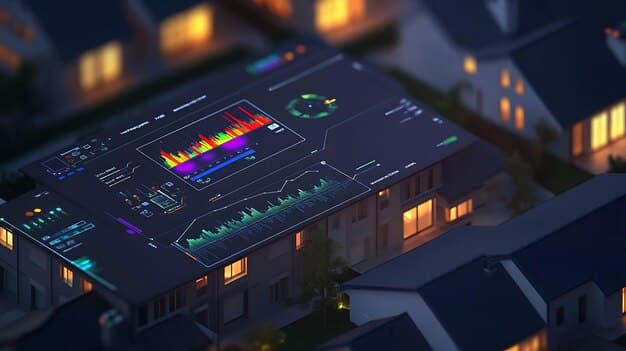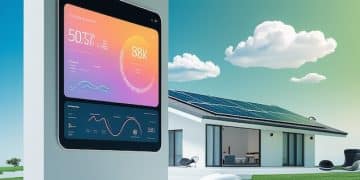Master Home Energy with Real-Time Management Systems

Anúncios
Home Energy Management Systems: Monitor and Control Your Energy Usage in Real-Time empower homeowners to gain unprecedented insight and command over their household energy consumption, driving efficiency and cost savings.
Imagine knowing exactly how much energy your home is consuming, right now, and having the power to adjust it with a tap. This vision is rapidly becoming a reality thanks to Home Energy Management Systems: Monitor and Control Your Energy Usage in Real-Time. These innovative technologies are transforming how we interact with our homes, moving beyond simple automation to genuine, impactful energy intelligence.
The advent of intelligent energy management
The evolving landscape of home technology is pushing us towards greater control and efficiency. Historically, energy consumption was a mystery until the monthly bill arrived, offering little opportunity for proactive adjustments. Today, the integration of smart devices and advanced analytics is fundamentally changing this dynamic, putting the power directly into the hands of homeowners.
This paradigm shift isn’t just about convenience; it’s about empowerment. Understanding your energy footprint in real-time allows for informed decisions that can lead to significant cost reductions and a smaller environmental footprint. It transforms a passive expenditure into an active area of optimization.
From basic monitoring to full control
Early iterations of home energy management were often limited to basic monitoring—showing historical data or current consumption without providing actionable insights. Modern Home Energy Management Systems (HEMS), however, have evolved to integrate seamlessly with various smart home devices, creating a cohesive ecosystem. This integration extends beyond mere data display, offering the ability to remotely control appliances, adjust thermostats, and even manage solar energy production and battery storage.
Consider the potential:
- Receive alerts when energy consumption peaks during off-peak hours.
- Automate appliance usage to align with optimal energy rates.
- Integrate with renewable energy sources for self-sufficiency.
- Identify energy vampire devices draining power silently.
The comprehensive nature of contemporary HEMS represents a significant leap forward. It moves beyond simple awareness to providing the tools necessary for practical implementation of energy-saving strategies. This level of control empowers homeowners to become active participants in their energy narrative.
Furthermore, the intelligence embedded in these systems allows for learning and adaptation. Over time, a HEMS can learn your household’s energy patterns and suggest optimized schedules or even make adjustments autonomously based on preferences and external factors like weather forecasts or utility pricing. The system becomes a proactive assistant, constantly working to enhance efficiency. This is a far cry from passive energy monitoring and highlights the ‘management’ aspect of these advanced systems.
Components of a comprehensive HEMS
A robust Home Energy Management System (HEMS) is typically a sophisticated network of interconnected devices and software, designed to provide a holistic view and control over your home’s energy consumption. Understanding these core components is key to appreciating the system’s capabilities. Each element plays a crucial role in collecting data, processing information, and enabling user interaction.
Smart meters and sensors
At the foundation of any good HEMS are smart meters and an array of sensors. Smart meters, often provided by utility companies, transmit detailed energy consumption data directly to the HEMS gateway. Beyond the utility meter, intelligent sensors can be installed on individual appliances or circuits to provide granular data on specific energy drains. This provides a detailed breakdown of where energy is being used, making it easier to pinpoint inefficiencies.
These sensors might include:
- Current clamps: Measuring electricity flow to individual devices.
- Temperature sensors: Informing thermostat adjustments and HVAC optimization.
- Motion sensors: Detecting occupancy to control lighting and climate in specific zones.
- Light sensors: Adjusting lighting based on natural light availability.
The data collected by these components forms the raw input that the HEMS processes to generate meaningful insights. Without accurate, real-time data from these sources, the system’s ability to monitor and control would be severely limited. The precision of these sensors is paramount in creating a truly effective management system.
Centralized control hub and software
The heart of every HEMS is its centralized control hub, often a dedicated hardware device, or sometimes an advanced router that integrates with cloud-based software. This hub acts as the brain, collecting data from all connected sensors and smart devices, processing it, and presenting it to the homeowner through a user-friendly interface—typically a mobile app, web dashboard, or dedicated touchscreen. The software is where the magic truly happens, allowing users to visualize energy usage, set schedules, receive alerts, and implement automated rules.
This central unit also serves as the communication bridge, using various protocols like Wi-Fi, Zigbee, or Z-Wave, to connect with a diverse range of smart home devices. It’s through this interface that users can remotely switch off lights, adjust heating, or review their energy expenditure from anywhere in the world. The intuitive design of this software is critical for user adoption and effectiveness, making complex energy data accessible and actionable.

Real-time monitoring: The key to informed decisions
The ability of Home Energy Management Systems to provide real-time data is arguably their most impactful feature. Unlike traditional energy bills that look backward at aggregated consumption, real-time monitoring offers an immediate, granular view of energy use as it happens. This immediacy creates a dynamic feedback loop that empowers homeowners to make informed decisions and effect immediate changes.
Understanding that every flick of a switch or adjustment to the thermostat has an instantaneous, visible impact can be a powerful motivator for behavioral change. It transforms abstract energy units into concrete, understandable figures, fostering a deeper awareness of consumption habits. This level of transparency is unprecedented and crucial for optimizing energy usage effectively.
Identifying energy vampires and inefficiencies
One of the most valuable aspects of real-time monitoring is its capacity to identify “energy vampires”—devices that consume power even when turned off or in standby mode. These silent drains can add up significantly over time, unnoticed without continuous monitoring. A HEMS can pinpoint exactly which devices are drawing constant power, allowing homeowners to unplug them or use smart plugs to eliminate standby current.
Beyond individual devices, real-time data helps uncover broader inefficiencies within the home. Perhaps a drafty window is causing excessive heater usage, or an old appliance is consuming far more power than expected. By observing consumption patterns throughout the day, homeowners can identify peak usage times, unexpected spikes, and consistent drains, leading to better optimization strategies. For instance, noticing a significant energy spike every time the old refrigerator turns on might signal it’s time for an upgrade.
Optimizing peak and off-peak usage
Many utility companies implement time-of-use (TOU) tariffs, where electricity prices vary based on the time of day. Energy is typically more expensive during peak demand hours and cheaper during off-peak times. Real-time monitoring allows homeowners to understand these price fluctuations and adjust their energy consumption accordingly. A HEMS can even automate this process, scheduling energy-intensive tasks like charging electric vehicles or running dishwashers during cheaper off-peak hours.
This dynamic optimization is a game-changer for reducing electricity bills. By shifting consumption away from high-tariff periods, homeowners can significantly cut costs without necessarily reducing overall energy use. The system makes complex tariff structures understandable and actionable, transforming a potential cost burden into an opportunity for savings. This strategic shift not only benefits the wallet but also helps stabilize the energy grid by balancing demand.
Control at your fingertips: Automating energy savings
Beyond just monitoring, the true power of a Home Energy Management System lies in its ability to offer comprehensive control. This isn’t just about flipping switches remotely; it’s about smart automation that learns your habits, responds to external factors, and proactively adjusts settings to optimize energy consumption without sacrificing comfort. This level of intelligent control provides a constant, almost invisible, effort towards efficiency.
Remote control and scheduling of devices
Modern HEMS platforms provide intuitive mobile applications and web interfaces that allow users to control connected devices from anywhere in the world. Forgot to turn off the lights before leaving for vacation? Or want to pre-cool your home before arriving back from work? These systems make it possible. This remote accessibility offers both convenience and significant energy-saving potential by ensuring that energy is only consumed when truly needed. The ability to manage your home’s energy footprint while away means peace of mind and tangible savings.
Programmable schedules are another cornerstone of HEMS control. Users can set up routines for lighting, heating, air conditioning, and even smart outlets connected to appliances. For example, lights can automatically turn off when you leave a room, or the thermostat can adjust based on your daily schedule. This means energy use aligns perfectly with your lifestyle, ensuring efficiency without conscious, moment-to-moment management. This feature eliminates human error in leaving devices on unnecessarily.
Integration with smart home ecosystems
The effectiveness of a HEMS is greatly enhanced by its ability to integrate with existing smart home ecosystems (like Amazon Alexa, Google Home, Apple HomeKit, or myriad others). This interoperability allows various smart devices—from smart thermostats and lighting to washing machines and EV chargers—to communicate and work in concert under the HEMS umbrella. This creates a truly unified system where energy management is not an isolated function but an integrated part of your smart home experience.
This seamless integration enables sophisticated automation scenarios. For instance, your HEMS could automatically reduce heating when a smart door lock indicates you’ve left the house, or prioritize charging your electric vehicle when solar production is at its peak. The synergy between devices maximizes efficiency by allowing them to respond to each other, creating a dynamic and optimized energy environment. This interconnectedness is essential for a holistic approach to energy saving, moving beyond isolated device control to coordinated system-wide optimization.
Environmental impact and financial benefits
Adopting a Home Energy Management System (HEMS) is more than just a technological upgrade; it’s a strategic decision with profound implications for both your wallet and the planet. The tangible benefits extend far beyond convenience, offering significant environmental advantages and substantial financial returns. In an era where sustainability and economic prudence are paramount, HEMS offer a compelling solution.
Reducing carbon footprint
By optimizing energy consumption, HEMS directly contribute to a reduction in greenhouse gas emissions. When homes use less electricity, especially during peak demand periods, it lessens the strain on power grids which often rely on fossil fuel burning “peaker plants” to meet demand. Every kilowatt-hour saved means less reliance on energy sources that contribute to climate change. This makes adopting a HEMS a direct action towards fighting global warming.
Furthermore, HEMS can facilitate the integration of renewable energy sources, such as rooftop solar panels. By intelligently managing the flow of solar energy into the home, potentially storing excess in batteries, and optimizing its use, HEMS empower homeowners to maximize their clean energy consumption and reduce their reliance on grid power. This shift towards self-consumption of renewables significantly lowers a household’s carbon footprint, making a noticeable difference in their environmental legacy. It’s about more than just saving energy; it’s about using energy more responsibly.
Significant cost savings on utility bills
The financial benefits of implementing a HEMS can be substantial and accrue over time. By providing real-time data, identifying energy inefficiencies, automating device schedules, and optimizing usage during off-peak hours, a HEMS empowers homeowners to drastically cut down on their electricity bills. The precise control offered by these systems translates directly into fewer wasted kilowatt-hours, leading to noticeable savings month after month.
The investment in a HEMS typically pays for itself through these accumulated savings. Depending on the size of the home, existing energy habits, and utility rates, homeowners can expect to see a return on their investment within a few years. Beyond just electricity, some HEMS can also help manage gas and water consumption, further broadening the scope of potential savings. This financial incentive makes the transition to smart energy management an attractive proposition for any budget-conscious household. It’s an investment that reliably pays dividends.

Choosing the right HEMS for your home
Selecting the ideal Home Energy Management System for your specific needs can feel daunting given the array of options available. It’s not a one-size-fits-all solution, and what works best for one household might not be suitable for another. A careful evaluation of your home’s characteristics, your personal energy goals, and the system’s features is crucial to making an informed decision.
Assessing needs and current infrastructure
Before diving into product specifications, begin by understanding your current energy landscape. What are your main energy concerns? Is it high electricity bills, a desire for greater environmental responsibility, or maximizing self-consumption from solar panels? Consider the size of your home, the age of its appliances, and your existing smart home devices. Does your home already have a smart thermostat or smart lighting? The answers to these questions will help narrow down the options and ensure compatibility.
Also, think about your comfort with technology. Are you looking for a simple plug-and-play solution, or are you comfortable with a more complex, highly customizable system? Your home’s internet connectivity and Wi-Fi coverage will also be critical factors, as most HEMS rely heavily on a stable network connection for real-time data transmission and remote control. A comprehensive assessment of your existing infrastructure helps determine the level of integration and complexity your home can support.
Key features to look for in a HEMS
When evaluating different HEMS, several key features stand out as essential for effective energy management. Prioritize systems that offer:
- Real-time Data and Analytics: Granular, immediate insights into consumption.
- Integration Capabilities: Compatibility with a wide range of smart devices and utility programs.
- Automation and Scheduling: Ability to set rules and routines for devices.
- User-Friendly Interface: Intuitive mobile app or web dashboard for easy control.
- Scalability: The option to expand the system with more devices or features later.
- Security and Privacy: Robust data protection and privacy policies.
- Customer Support: Reliable technical assistance when needed.
Consider the upfront cost versus the potential long-term savings. Some systems have a higher initial investment but offer more advanced features and greater efficiency, ultimately leading to faster payback. Reading reviews, comparing features, and potentially consulting with energy professionals can further guide your decision, ensuring you select a system that aligns with your specific objectives for energy efficiency and home automation.
The future of home energy management
The trajectory of Home Energy Management Systems is one of continuous innovation and deeper integration. As technology advances and societal priorities shift towards sustainability, HEMS are poised to become an indispensable part of every modern home. The vision extends beyond mere efficiency, evolving towards truly autonomous and resilient energy ecosystems.
AI and machine learning integration
The next frontier for HEMS undoubtedly lies in the enhanced application of artificial intelligence (AI) and machine learning (ML). While current systems offer some level of learning, future iterations will leverage more sophisticated algorithms to predict energy needs with greater accuracy, anticipate grid fluctuations, and optimize energy flow more autonomously. AI-powered HEMS will learn individual household habits down to the most minute detail, adjusting settings proactively to maintain comfort while minimizing costs without direct user intervention.
Imagine a system that not only learns your preferred temperature but also factors in the local weather forecast, the daily rhythm of sunlight entering your home, and even the real-time cost of electricity to perfectly pre-cool or pre-heat your home before you arrive. ML will enable predictive maintenance for high-consuming appliances, alerting users to potential issues before they lead to increased energy use or costly breakdowns. This level of predictive intelligence will transform energy management from reactive to truly proactive.
Grid integration and virtual power plants
As renewable energy sources like solar and wind become more prevalent, the stability of the traditional energy grid faces new challenges. HEMS are crucial in facilitating better grid integration, enabling what are sometimes called “virtual power plants” (VPPs). In this scenario, numerous homes equipped with HEMS, solar panels, and battery storage can collectively act as a decentralized power resource, feeding excess energy back to the grid when needed and drawing from it during low-cost periods.
This bidirectional energy flow, managed by advanced HEMS, will not only make individual homes more self-sufficient but also contribute to a more resilient, efficient, and sustainable national grid. HEMS will become tools for demand-side management, allowing utilities to incentivize users to reduce consumption during peak stress times on the grid or even to release stored energy from home batteries. This symbiotic relationship between homes and the grid represents a significant leap towards a truly smart and sustainable energy future, where every home plays a role in energy stability.
| Key Point | Brief Description |
|---|---|
| 💡 Real-Time Insights | Monitor energy usage instantly to identify vampires and optimize consumption patterns. |
| ⚙️ Automated Control | Schedule devices and integrate with smart home systems for effortless savings. |
| 💰 Cost & Carbon Savings | Lower utility bills and reduce environmental impact through smarter energy use. |
| 🚀 Future-Proofing | AI, ML, and grid integration promise an even more intelligent energy future. |
Frequently Asked Questions About HEMS
A Home Energy Management System (HEMS) is an intelligent platform allowing homeowners to monitor, control, and optimize their household energy consumption in real-time. It integrates various smart devices and sensors to provide detailed insights into energy usage, automate device operation, and identify inefficiencies, ultimately leading to reduced utility bills and a smaller carbon footprint.
HEMS save money by providing real-time data that helps identify energy-wasting habits and “energy vampire” devices. They allow scheduling of high-consumption activities during off-peak, cheaper hours, and enable remote control to turn off forgotten devices. By optimizing usage patterns and making energy visible, homeowners can actively reduce their consumption and take advantage of tiered pricing structures.
Many modern HEMS are designed for extensive compatibility, often integrating with popular smart home ecosystems like Amazon Alexa, Google Home, and Apple HomeKit. They typically support various communication protocols (Wi-Fi, Zigbee, Z-Wave) to connect with a wide array of smart thermostats, lighting, appliances, and smart plugs, creating a unified energy management platform. It’s essential to check specific product compatibilities.
A HEMS typically provides a wealth of data, including real-time electricity consumption (current draw in watts), historical usage trends (daily, weekly, monthly), cost breakdowns by appliance or circuit, and peak demand periods. Some systems can also show solar power generation, battery charge levels, and even estimate carbon emissions, empowering highly detailed energy analysis and decision-making.
The complexity of HEMS installation varies. Some basic systems are relatively simple, involving plug-and-play smart plugs and easy app setup. More sophisticated systems, especially those integrating with main electrical panels or solar arrays, might require professional installation or a qualified electrician. Most systems are designed for user-friendliness, with intuitive interfaces and clear instructions making daily operation straightforward after initial setup.
Conclusion
The transformative potential of Home Energy Management Systems: Monitor and Control Your Energy Usage in Real-Time is undeniable. These sophisticated solutions are empowering homeowners to move beyond passive consumption, offering unprecedented visibility and active control over their energy footprint. From identifying hidden energy drains to orchestrating smart automation and integrating with renewable sources, HEMS are pivotal tools for achieving significant cost savings and contributing to a more sustainable planet. As these systems continue to evolve with AI and deeper grid integration, they are not just smart devices; they are a fundamental component of the intelligent, efficient, and resilient homes of the future. The time to embrace this technological shift, for both individual benefit and collective environmental good, is now.





